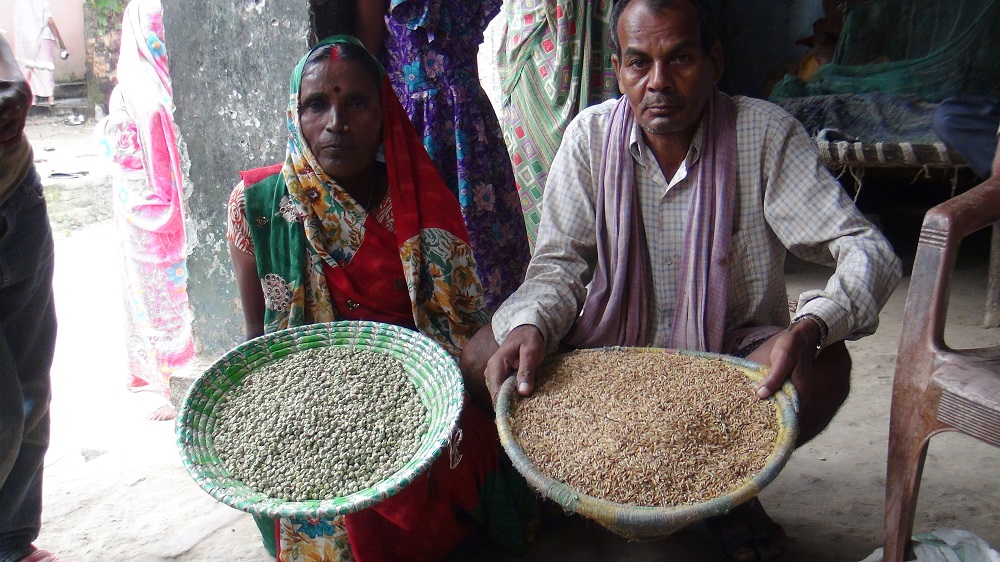Planetary health diets are seen as the core vehicle for attaining the United Nations’ Sustainable Development Goals and the Paris Agreement by 2050. These diets, low in animal-sourced food and composed mainly of plant-based food sources, require radically transforming global food systems through major paradigm shifts in dietary habits and diets. The success of adopting such planetary health diets, however, crucially hinges on people, and more specifically on their culture, context, socioeconomic status, food environment, attitudes, perceptions, beliefs, and behavior towards food choice.

.
The EAT-Lancet Commission, a non-profit think-tank of 37 leading scientists from 16 countries in various disciplines including human health, agriculture, political sciences, and environmental sustainability, published an urgent call for “planetary health diets”; i.e., diets that improve both human health and environmental sustainability.
 Planetary health diets are seen as the core vehicle for attaining the United Nations’ Sustainable Development Goals and the Paris Agreement by 2050. These diets, low in animal-sourced food and composed mainly of plant-based food sources, require radically transforming global food systems through major paradigm shifts in dietary habits and diets. The success of adopting such planetary health diets, however, crucially hinges on people, and more specifically on their culture, context, socioeconomic status, food environment, attitudes, perceptions, beliefs, and behavior towards food choice.
Planetary health diets are seen as the core vehicle for attaining the United Nations’ Sustainable Development Goals and the Paris Agreement by 2050. These diets, low in animal-sourced food and composed mainly of plant-based food sources, require radically transforming global food systems through major paradigm shifts in dietary habits and diets. The success of adopting such planetary health diets, however, crucially hinges on people, and more specifically on their culture, context, socioeconomic status, food environment, attitudes, perceptions, beliefs, and behavior towards food choice.
Yet, the diversity and cultural drivers of food choice are still insufficiently understood.
People do not just eat nutrients or ingredients; instead, dietary patterns are part of a system, which is shaped and driven by culture, context, socioeconomic status, food environment, and hedonic motivation. The High Level Panel of Experts on Food Security and Nutrition of the Committee on World Food Security recently proposed a holistic, conceptual framework for food systems for diets and nutrition.
The framework explicitly recognizes the role of culture as a driver of food environments and consumer food choice behavior and diets, the latter being presented as the critical link between food supply chains and nutrition and health outcomes. The academic community has realized that generating a better understanding of cultural and hedonic drivers of food choice requires merging the fields of gastronomy and food science
The Gastronomic Systems Research framework
In response to this need for interdisciplinary and systemic approaches, Cuevas et al. recently proposed the Gastronomic Systems Research (GSR) framework, arguing that the cultural drivers of food choice are shaped by a hierarchical system of food consumption occasions or meals that command a set of dish options, which, on their turn, determine a set of ingredients and ingredient pairings that have particular hedonic qualities and nutritional attributes, and feature specific cooking methods.
Consumption of these dishes results—ultimately—in intermediate outcomes such as nutrition diversity of consumer diets, and final outcomes such as nutrition and health status of consumers. Thus, the GSR framework not only helps the science of food choice gain a better understanding of why, when, and what people eat; it also unveils possible entry points for nutrition interventions that can assist nutritionists, policymakers, and food system actors in developing planetary health diets.
Two of India’s poorest states, Odisha and West Bengal, are the perfect venues to study the science of food choice through the GSR framework with the aim of formulating nutrition interventions to nudge consumers towards planetary health diets. In Odisha, 32.6% of the population lives below the poverty level. In West Bengal, around 20% of the population lives below the national poverty threshold. In both states, people mainly eat starchy staples (e.g., rice and potato), which provide energy but are nutritionally poor.
Food is an essential part of Indian culture
More nutritious food (e.g., milk and vegetables) is reported to be largely inaccessible to the poor. Even with people’s dependence on starchy staples, gender-disaggregated state- and community-based measures of chronic energy deficiency indicate that significant proportions of the populations in both Odisha and West Bengal are undernourished.
The high level of food insecurity is associated with high mortality rates in Odisha. On the other hand, undernutrition has been linked with widespread stunting and thinness in adolescents in West Bengal. Achieving planetary health diets in eastern India will be impossible, though, without a baseline on the diversity of food choices and a thorough understanding of the systemic cultural drivers of food choice.
Food is an essential part of Indian culture and deeply rooted in the country’s history, traditions, lifestyles, and customs. In fact, the foundation of various traditional dishes prepared and eaten by people in India is derived from “Ayurveda”, an Indian traditional medicine system based on the human body as the product of food intake. Previous studies have indicated that Indian consumers are increasingly considering health benefits in food choices. It is also indicated that consumers in middle- and higher-income groups are significantly upgrading and diversifying their diets by including higher valued food items.
However, information is scant about poor people’s preferences, nutritional intake, and awareness about various food items they consume on a regular basis. In eastern India, for instance, fragmented studies report the effects of malnutrition in the region but the nutritional intake and interventions required to improve it have not been investigated comprehensively.
Eating behaviors are often associated with caloric intake and body mass metrics. Yet, increasing food availability (i.e., productivity) and consumer accessibility (i.e., increasing consumer income) does not automatically translate into improved nutritional status.
Investing in improving nutrition is crucial in accelerating economic development through increased productivity and poverty reduction. Little is known about how eating behaviors drive food choices but food choice is an important consideration in developing nutrition interventions. It must be noted that food habits are shaped by the processes of choosing, acquiring, distributing, cooking, serving, and sharing food.
On the other hand, food choices can also serve as a means of communicating personal identity and emotional reasoning (i.e., food voice); for example, refusing to partake of a certain food (e.g., veganism or fasting as a means of political protest) or opting for specific dishes can deliver a powerful message. In addition, food choices tell the story of family struggles, migrations, resistance, assimilation, adaptation, and group identity.
Food choice results from a complex set of human behaviors and is influenced by biological and genetic influences on eating behavior as well as socioeconomic and cultural factors and is not only about consuming calories for sustenance. Thus, any attempt in developing interventions to improve the nutritional status of consumers has to consider systemic drivers of food choice such as culture, context, socioeconomic status, food environment, and hedonic motivation.
The GSR framework has been previously piloted in the Philippines and applied to the case of rice-based diets of a target population of middle-to high-income Filipino consumers. However, the framework has not yet been implemented in the socioeconomic context of poor households and the rich cultural and gastronomic context of India.
The current paper aims to address the research gaps mentioned throughout this introduction and provide a useful baseline for nutritionists, policymakers, and food system actors as a first step in the design of nutrition intervention strategies to develop planetary health diets in eastern India. To achieve this goal, we use expert elicitation to contextualize the GSR framework to a target population of low-to middle-income households in Odisha and West Bengal to capture the diversity and cultural drivers of food choice and its nutritional implications in rice-based diets in eastern India.
Understanding and identifying traditional food choices
Understanding and identifying the traditional food choices and changing food patterns was challenging given the heterogeneity of food culture and diversity within different regions and communities within the two states.
Expert elicitation is, hence, a useful first step in capturing the diversity of food choices of a target population and identifying nutrition interventions that can nudge consumers towards planetary health diets. The gastronomic system mapped by the experts provides a first glimpse of the potentially unhealthy occasions, dishes, and ingredients in eastern India.
The gastronomic system captured in the database through expert elicitation provides a useful baseline for nutritionists, policymakers, and food system actors designing nutrition intervention strategies with the aim of catalyzing dietary changes towards planetary health diets.
At the most basic level, interventions can target ingredients or types of food (e.g., fruits and vegetables) and focus on improving the balance of nutrients (e.g., macro- and micronutrients) by encouraging the consumption of healthy ingredients, discouraging the consumption of unhealthy ingredients, and promoting diet diversity through ingredient diversity. At the dish level, interventions can target dishes and dish preparation techniques by encouraging the consumption of healthy dishes, discouraging the consumption of unhealthy dishes, and promoting diet diversity through dish diversity.
Finally, interventions can target the occasion level by encouraging healthy eating behavior and discouraging unhealthy eating behavior, based on better planning of eating occasions (e.g., “Breakfast like a king, lunch like a prince and dine like a pauper”) or introducing new occasions (e.g., healthy AM or PM snack, based on fruits or vegetables).
A shift towards planetary health diets will require a change in general nutrition education and “local interpretation and adaptation that reflects the culture, geography, demography of the population, and individuals”.
Through the GSR framework, the experts provided rich contextual information on the local food culture in eastern India, including the nutritive value of commonly consumed dishes. Nutritionists, policymakers, and food system actors can simultaneously target all three entry points in their nutrition intervention programs to nudge households towards planetary health diets while preserving the rich cultural heritage on which their gastronomic system is based.
Read the full study:
Samaddar A, Cuevas RP, Custodio MC, Ynion, J, et al. (2020) Capturing diversity and cultural drivers of food choice in eastern India. International Journal of Gastronomy and Food Science.






